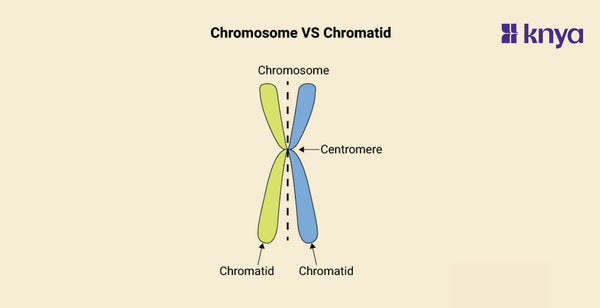Chromosome vs Chromatid: Chromosomes can be described as well-organized libraries that contain your genetic material (DNA). These libraries make identical twins known as chromatids in order to reproduce their contents prior to cell division. These chromatids remain together at a central "binding point" until cell division commences, at which time they split off, bringing a copy of the library with them to every new daughter cell. Therefore, chromatids are the identical halves generated after DNA replication, ready to be dispersed during cell division, whereas chromosomes are the entire bundle.
[image_banner]
Chromosome
- An organized structure carrying genetic material (DNA) within a cell.
- Condensed, compact X shape after DNA replication.
- Each cell has a specific, constant number (e.g., humans have 46).
- Made of two sister chromatids joined at a centromere.
Chromatid
- One of two identical halves of a duplicated chromosome during cell division.
- Uncondensed, individual strand before separation during cell division.
- Double the number of chromosomes during cell division (e.g 92 chromatids in human dividing cells).
- Becomes a full chromosome after separation during cell division.
Difference Between Chromosome and Chromatid
Chromosome and chromatid are related terms that are associated with the structure and organization of genetic material in cells. These are how they are different from one another.
|
Feature |
Chromosome |
Chromatid |
|
Definition |
Thread-like structures with DNA and proteins |
One of the two identical halves of a replicated chromosome |
|
Number in cells |
Varies among species |
Two chromatids per chromosome |
|
Function |
Carry genetic information, hereditary traits transmission |
Distribute genetic material during cell division |
|
Structure |
Two chromatids connected by a centromere |
Identical copies formed through DNA replication |
|
Occurrence |
Present in both eukaryotic and prokaryotic cells |
Specific to eukaryotic cells during certain stages of the cell cycle |
|
Formation |
Formed during cell division when DNA is tightly coiled |
Formed through DNA replication during the S phase of the cell cycle |
|
Genes |
Contain genes encoding specific proteins or traits |
Carry the same genetic information as the parent chromosome |
|
Diploid Number |
Present in pairs in diploid organisms |
Part of the diploid chromosome complement |
|
Variability |
Undergo genetic recombination during meiosis, leading to genetic variability |
Involved in the transmission of genetic material, maintaining genetic stability |
|
Number Variation |
Number varies between species; humans have 46 chromosomes |
Chromatids are part of the chromosome structure, contributing to the total chromosome count |
Browse Best Scrubs Collection
What is chromosome?
Imagine a tightly wound thread of genetic material, packed with all the instructions to build and run an organism. That's a chromosome! It's like a blueprint, carrying genes that determine everything from your eye color to your susceptibility to certain diseases. Chromosomes are found in the nucleus of every cell and come in pairs, one inherited from each parent.
Key Features of Chromosome:
- Chromosomes appear during cell division and consist of two tightly bound sister chromatids, each containing a replicated DNA molecule. Think of them as identical twins tightly holding hands.
- DNA coils around proteins called histones, forming structures called chromatin. These "beads on a string" compact the long DNA molecule, fitting it within the cell nucleus.
- Each species has a characteristic number of chromosomes. Humans, for example, have 46 chromosomes in 23 pairs. Maintaining this number ensures proper growth and development.
- Chromosomes carry genes, the blueprints for our traits. Their orderly pairing and segregation during cell division ensure accurate inheritance of genetic information.
[image_banner]
What is chromatid?
Think of a chromosome duplicating itself, creating identical twins. These twin strands, still attached at a central point called the centromere, are called chromatids. They're like two copies of the same instruction manual, ready to be distributed to new cells during cell division. Each daughter cell gets one chromatid from each chromosome pair, ensuring they have the complete set of genetic information.
Key Features of Chromatid:
- During cell division, sister chromatids duplicate and separate, becoming individual chromatids in the daughter cells. They carry identical copies of the DNA molecule.
- The sister chromatid relationship is temporary, lasting only until cell division. Once separated, they become individual chromosomes in the daughter cells.
- During meiosis, the specialized cell division for gamete formation, chromatids can exchange genetic material through a process called crossing over. This adds to the variation in offspring.
- Errors in chromosome number or structure, called chromosomal abnormalities, can lead to genetic disorders like Down syndrome. Understanding chromatid behaviour is crucial for studying these conditions.
Shop Best Lab Coats fromHere!
Similarities Between Chromosome and Chromatid
- Genetic Material: DNA, which is the genetic information's carrier, is found in both chromatids and chromosomes.
- Replication: The process by which chromosomes replicate creates chromatids.
- Cell Division: Chromosomes and chromatids are both necessary for the proper transfer of genetic material to daughter cells during cell division.
- Structural Basis: Two chromatids joined by a centromere comprise a chromosome, and chromatids make up the structure of chromosomes.
- Centromere: The centromere, present in both chromatids and chromosomes, is essential for ensuring appropriate division of the two during cell division.
Though both residing in the nucleus and carrying our genetic blueprints, chromosomes and chromatids play distinct roles in the cell's life cycle. While a chromosome is the condensed, single DNA molecule holding all our genes, a chromatid is one of its two identical halves formed during replication in preparation for cell division. Think of a chromosome as a complete book with all the chapters, and a chromatid as one of the two identical copies of that book. Understanding their key differences, such as structure, timing of existence, and identity, is crucial for unraveling the intricate dance of cell reproduction and inheritance. So, next time you hear these terms, remember: chromosomes are the permanent residents, holding the complete story, while chromatids are temporary players ensuring its faithful replication and distribution.
| Check out More Articles | |
| Difference Between Psychosis and Neurosis | |
| Dorsal Vs Ventral | |
| Difference Between Striated and Unstriated Muscles |















